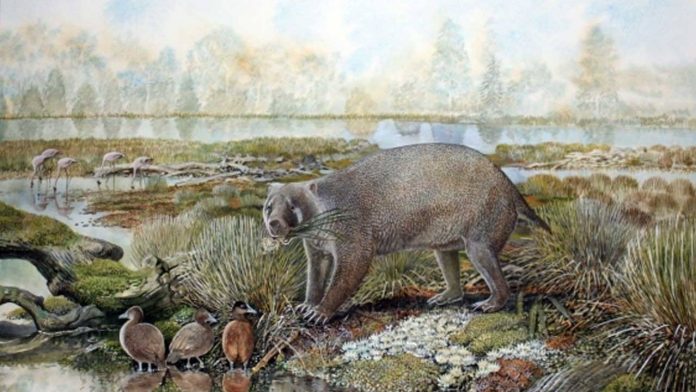Paleontologists have identified a giant wombat-like marsupial that lived 25 million years ago (Oligocene epoch) in what is now Australia. Named Mukupirna nambensis, the prehistoric creature was at least five times larger than living wombats and so different that the researchers have had to create a new family to accommodate it.
The fossilized remains of Mukupirna nambensis — a partial skull and most of the skeleton — were found in 1973 in the clay floor of Lake Pinpa in northeastern South Australia by an expedition led by Dr. Richard Tedford from the American Museum of Natural History.
“It was an extremely serendipitous discovery because in most years the surface of this dry lake is covered by sands blown or washed in from the surrounding hills,” said Professor Mike Archer, a scientist in the PANGEA Research Centre at the University of New South Wales.
“But because of rare environmental conditions prior to our arrival that year, the fossil-rich clay deposits were fully exposed to view. And this unexpected view was breathtaking.”
“On the surface, and just below we found skulls, teeth, bones and in some cases, articulated skeletons of many new and exotic kinds of mammals. As well, there were the teeth of extinct lungfish, skeletons of bony fish and the bones of many kinds of water birds including flamingos and ducks.”
“These animals ranged from tiny carnivorous marsupials about the size of a mouse right up to Mukupirna nambensis which was similar in size to a living black bear. It was an amazingly rich fossil deposit full of extinct animals that we’d never seen before.”
Mukupirna nambensis weighed about between 143 and 171 kg, similar in size to a black bear, and that it was probably a strong digger.
An analysis of evolutionary relationships shows that the ancient animal is most closely related to wombats, but it has several unique features.
“Mukupirna nambensis clearly was an impressive, powerful beast, at least three times larger than modern wombats,” said Dr. Robin Beck, a researcher at the University of Salford.
“It probably lived in an open forest environment without grasses, and developed teeth that would have allowed it to feed on sedges, roots, and tubers that it could have dug up with its powerful front legs.”
“Mukupirna nambensis reveals a fascinating mix of characteristics and provides evidence of a close link between wombats and an extinct group of marsupials called wynyardiids,” said Dr. Pip Brewer, a scientist in the Department of Earth Sciences at the Natural History Museum, London.
“It suggests that adaptations for digging for food may have existed in the very earliest members of the wombat family and likely led to their eventual survival to the present day.”
“Although suggested previously, it had not been possible to test this, as the oldest fossil wombats discovered are only known from teeth and a few skull fragments.”
The team looked at how body size has evolved in vombatiforms, which is the group that includes Mukupirna nambensis, wombats, koalas and their fossil relatives, and showed that body weights of 100 kg or more evolved at least six times over the last 25 million years.





























